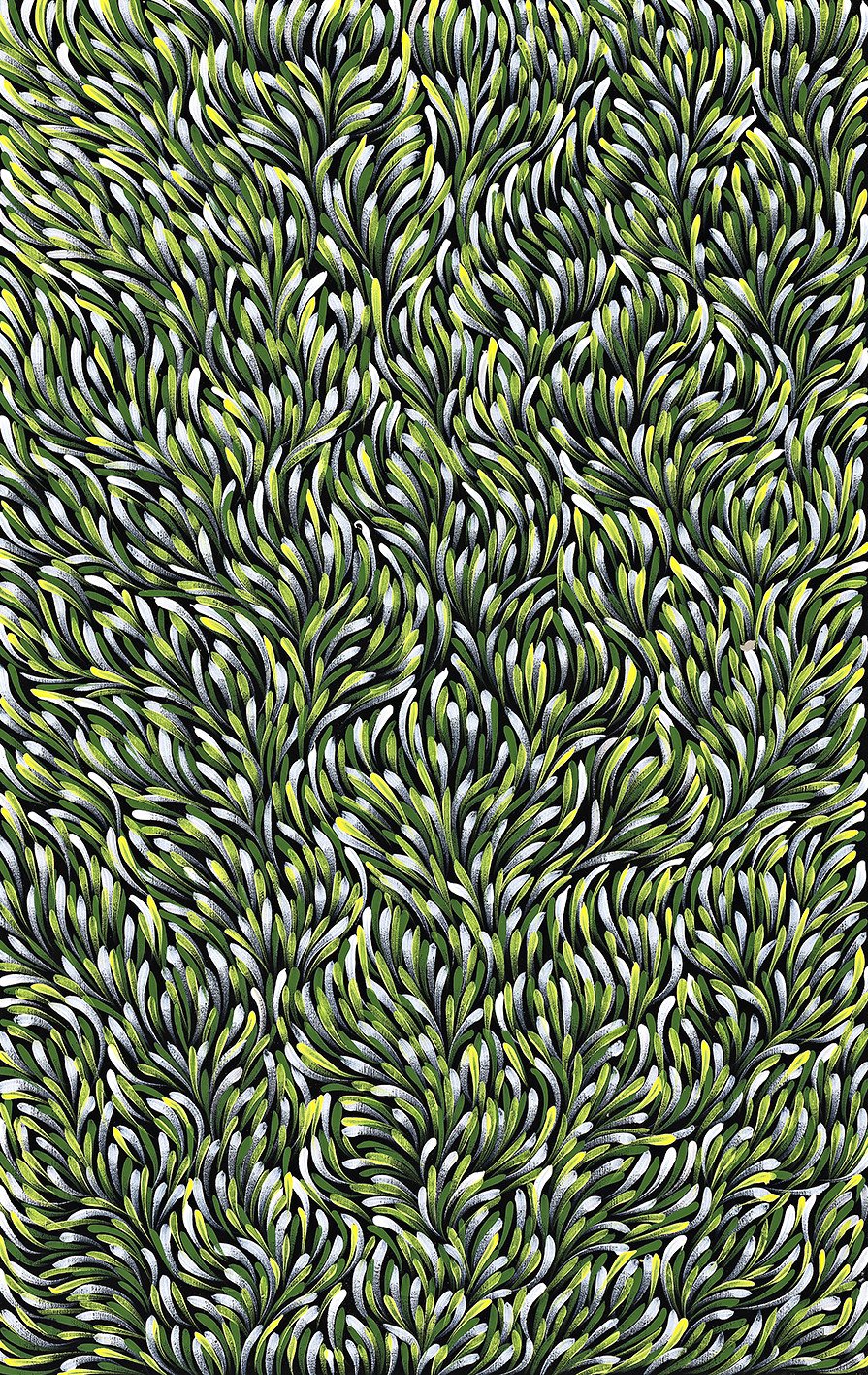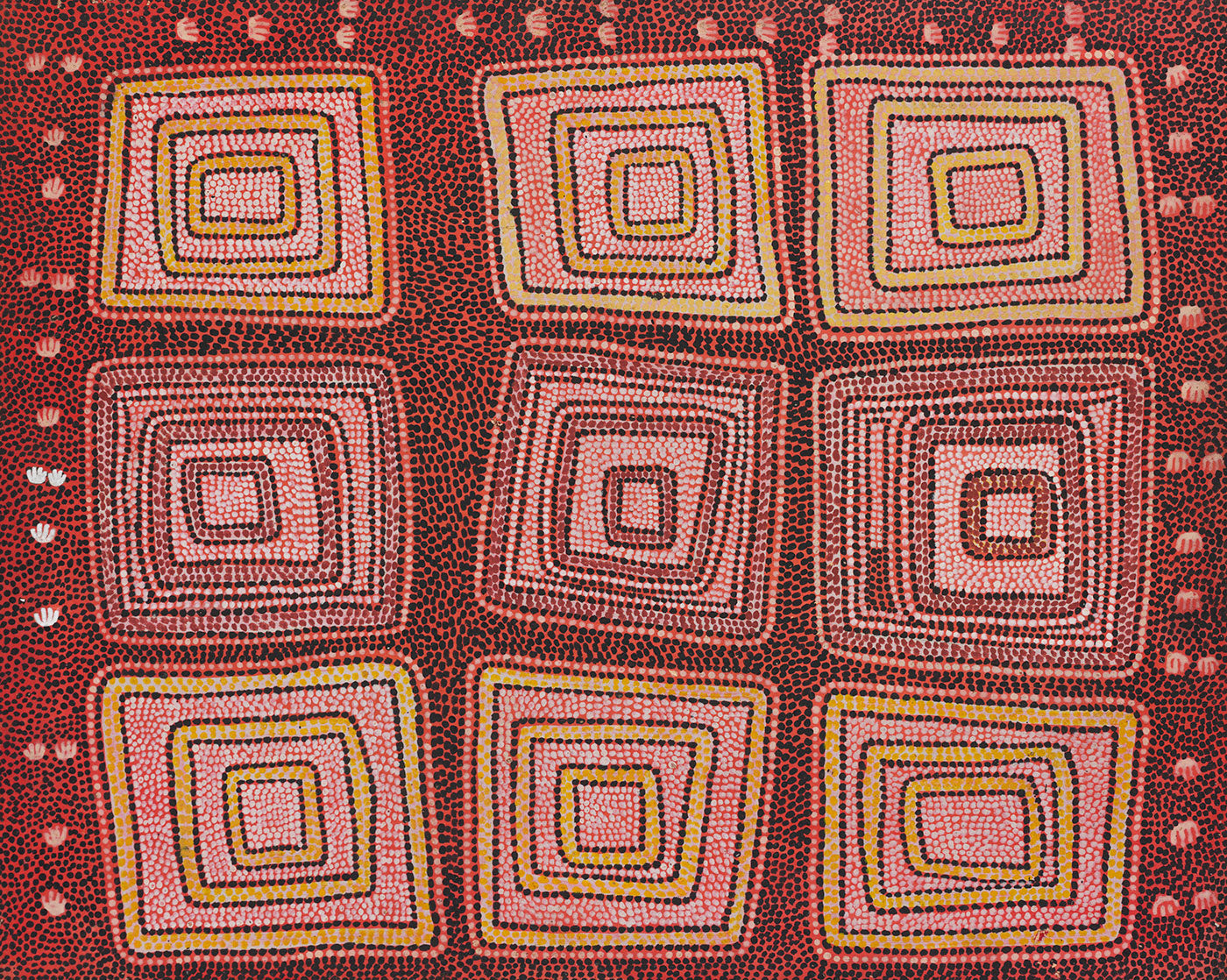Indigenous Artistic Styles
Australian First Nations art has become increasingly renowned nationally and internationally. Artists are admired for their ability to capture the essence of the colours and shapes of country while also communicating thousands of years of knowledge, wisdom and stories. Yet despite the increasing acknowledgement of Indigenous art, it still remains somewhat misunderstood by many. Often the first thing that will come to mind about Indigenous art is dot painting, yet dot is not the only Indigenous artistic style. Spread all across Australia there is an incredible diversity of artistic styles, unique to specific communities and localities, each with special stories to tell.
 Namarnkol (Barramundi) bark X-ray painting by Gabriel Maralngurra (Injalak Arts). Image sourced from Injalak Arts, 2021.
Namarnkol (Barramundi) bark X-ray painting by Gabriel Maralngurra (Injalak Arts). Image sourced from Injalak Arts, 2021.
Australian Indigenous art is one of the oldest artforms in the world, dating back 80,000 years. Traditional artforms are incredibly varied and once only utilised materials found in nature. This includes ochre, rock, bark, sand, and a range of plants used to make fibre crafts (Invaluable. 2020).
Here is a quick overview of some of the best known traditional art forms. Bradshaw paintings (Gwion Gwion) are some of the oldest figurative works of art in the world. This style is a form of rock art and is predominantly found in the Kimberly region of Northwest Australia. The artworks feature symmetrical figures wearing detailed accessories that communicate a sense of opulence. X-Ray painting also known as Rarrk painting is another art style that originated as rock art and was also traditionally painted onto bark. It is a traditional naturalistic style used by the people of Arnhem land in the Northern Territory. It is named X-Ray art because of the way that humans and animals are depicted showing their anatomical features including bone structures and internal organs. Lastly string art and weaving have always formed an important part of Indigenous art and culture. String art (jewellery) was traditionally a part of many ceremonies and weaving was used to create everyday tools, baskets, fishing nets and also ceremonial items (Invaluable. 2020). This is only a taste of some traditional Indigenous art styles, there many more styles and variations unique to different regions of Australia. You can learn more about each on the Kate Owen Gallery website.
 Gwion Gwion (Bradshaw) figures from the Sash era. Photo: Kimberley Foundation Australia. Image sourced from Creative Spirits, 2021.
Gwion Gwion (Bradshaw) figures from the Sash era. Photo: Kimberley Foundation Australia. Image sourced from Creative Spirits, 2021.
While many Indigenous artists continue to create art in traditional ways, new contemporary styles have also emerged. It was in the 1970s when community art centres began to be established that the modern Indigenous art movement began to gain recognition on a national and ultimately international level. New materials and techniques were introduced to Indigenous communities, opening up a world of new possibilities to the talented artists.
 Bush Medicine Leaves (2009) by Utopian artist Gloria Petyarre. Image sourced from Delmore Gallery, 2021.
Bush Medicine Leaves (2009) by Utopian artist Gloria Petyarre. Image sourced from Delmore Gallery, 2021.
Here’s a brief overview of some of the key modern styles that emerged. The most famous would have to be dot painting. Traditional dots and patterns would be drawn in the sand to share sacred stories associated with specific ceremonies. With the introduction of modern art materials dot painting emerged, the style protected the sacred symbols and meanings in the intricate patterns (Wye, 2020). Dub Dub painting is a style made famous by renowned utopian artist Emily Kame Kngwarreye. The vibrant contemporary style is achieved by pushing a paint laden brush across large canvases. Another well known modern style is Bush Medicine Leaves. The painting style began with Gloria Petyarre’s award winning artworks featuring bush medicine leaves from the Kurrajong tree. The incredibly fine leaves create dense flowing patterns. Naïve Indigenous art as the name would suggest is an art style that can be seen as somewhat innocent and simplistic in its characteristics. The artworks present the day-to-day life Australian Indigenous people executed in an innocent and untrained style (Kate Owen Gallery. 2020). Again this is only a very brief introduction into some modern Indigenous art styles, you can learn more here.

Naïve art style by Cherylyn Napangardi Granites. Image sourced from Kate Owen Gallery, 2021.
A key characteristic of Indigenous modern art is incredible vibrant colour combinations. As talked about in our blog post “Colours of Country” the use of the colour within Indigenous artworks is unparalleled. Artists create colour palettes that portray the beautiful diversity of colours that can be found across Australia’s vast natural landscapes. Traditionally natural coloured ochres were used however, once acrylic paints became available a whole new world of colour was opened up. Collectively communities of artists created new palettes, and began representing their country and stories in new contemporary ways.
Spread across Australia there are many artistic communities many of which are based in art centres of which there are now more than 90. Each community develops a unique art style and colour palette that is decided upon collectively. The system is completely unlike western art which is almost entirely focussed on the talents of individuals. Communities will work together to create art and develop new styles. With emergence of contemporary Indigenous art many modern styles have spread throughout Australia, yet each region or community will have their own special variation on these styles which often comes from their unique use of colour. Art communities such as Papunya Tula Artists have become renowned for their unique use of style and colour. Papaya Tula Artists were one of the first art communities to begin practicing new contemporary styles. Their style derives from artists' knowledge of the traditional sand body painting associated with ceremony (Papunya Tula Artists, 2014). Through the introduction of acrylic paints a distinctive style emerged, rich in colour and symbolism. You can learn more about Papunya Tula Artists here.
 Possum Men of Yirtjurunya by Anatjari Tjakamarra (Papunya Tula Artist). Image sourced from National Museum Australia, 2021.
Possum Men of Yirtjurunya by Anatjari Tjakamarra (Papunya Tula Artist). Image sourced from National Museum Australia, 2021.
One of our key aims through Yarn Marketplace is to showcase the incredible diversity of Indigenous artistic styles that exist within Australia. We aim to open the eyes of all Australians to the incredible beauty and cultural depth of these styles. Yarn showcases a diversity of artistic styles by collaborating with art centres and individual artists from all over Australia. Currently our key art centre partnership is with Warlukurlangu Artists a centre located in the remote community Yuendumu, Central Australia. You can find more about art centres, their incredible community benefits and unique artistic styles here.






